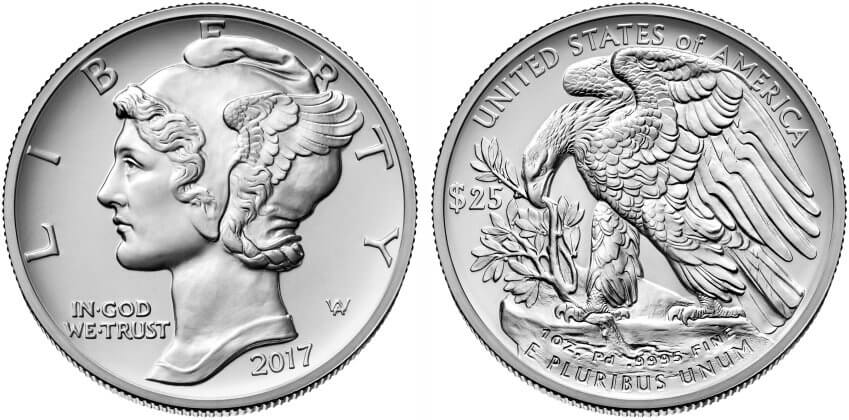Informative Guide to American Palladium Eagle Coins
Unlike silver and gold and to a lesser extent platinum, the rare precious metal palladium has been used much less frequently for bullion and collector coinage. The main series of palladium coins until recently was the Royal Canadian Mint’s Palladium Maple Leaf. This coin was minted intermittently from 2005 to 2009 and then again since 2015. Since 2017, The United States Mint has been producing 1 ounce Palladium Eagles in several distinct finishes in very low mintages.

Palladium Eagle Legislation
To prevent Canada from continuing to dominate the market for palladium coins and to help promote the palladium minting industry in the United States that is centered in Montana, Congress passed the American Palladium Eagle Coin Act of 2020 on December 10, 2010. The law called for the issuance of palladium bullion investment coins made of one troy ounce of .9995 palladium. The coins were to feature an obverse design based on Adolph Alexander Weinman’s famous motif of Liberty wearing a winged cap. Furthermore, a reverse image of an eagle based on the design he created for the 1907 American Institute of Architects gold medal. Both sides were struck in high relief.
Palladium Eagle Series by Year
2017 Palladium Eagle 2018 Palladium Eagle 2019 Palladium Eagle 2020 Palladium Eagle 2021 Palladium Eagle 2022 Palladium Eagle 2023 Palladium EagleHowever, the legislation also stipulated that the Mint had to first have a marketing study conducted. As the law states: “The market study described in paragraph (1) means an analysis of the market for Palladium bullion investments conducted by a reputable, independent third party. The study demonstrated that there would be adequate demand for palladium bullion coins produced by the U.S. Mint. This was needed to ensure that such coins could be minted and issued at no net cost to taxpayers.”
That study was completed in 2013 and found that a bullion palladium coin would likely not be profitable. The main reason was due to start-up costs for the program. The study showed collector coins might be profitable because they would be sold at a considerable mark-up over the Mint’s cost. The law also said that any collector versions had to have different surface treatments, i.e., finishes each year.
Design Legislation of the American Palladium Eagle Coin
‘‘(6) DESIGN.—Coins minted and issued under this subsection shall bear designs on the obverse and reverse that are close likenesses of the work of famed American coin designer and medallic artist Adolph Alexander Weinman—
‘‘(A) the obverse shall bear a high-relief likeness of the ‘Winged Liberty’ design used on the obverse of the so-called ‘Mercury Dime’;
‘‘(B) the reverse shall bear a high-relief version of the reverse design of the 1907 American Institute of Architects Medal; and
‘‘(C) the coin shall bear such other inscriptions, including “LIBERTY, ” “IN GOD WE TRSUT,” “UNITED STATES OF AMERICA,” the denomination and weight of the coin and the fineness of the metal, as the Secretary determines to be appropriate and in keeping with the original design.
Time passed, and the coins were not issued due to the concerns raised in the study. But then in December 2015 a new law was passed. It effectively made it possible for the mint to begin an American Palladium Eagle program in 2017. The proceeded with a bullion version that was limited to 15,000 coins.
That was followed in 2018 by a Proof version also limited to 15,000. Then in 2019 the struck a Reverse Proof coin with a maximum mintage of 20,000 that did not sell out. In 2020 they struck an uncirculated version limited to 10,000. In 2021, the Mint struck a second Proof limited to 12,000 and a bullion coin limited to 8,700 that sold out immediately. Finally, in 2022, the Mint planned to issue a second Reverse Proof coin limited to 7,500 coins.
One issue that the enabling legislation did not give enough consideration to because it was hard to predict at the time is the rising cost of palladium over the past couple years. Price increases has driven the cost of these coins up sharply to as much as $3,800 per coin in 2020. At this time, palladium was $3,000 per ounce and is the reason for the lower level of sales since 2020.
Palladium Eagle Composition and Specifications
Each American Palladium Eagle is made from one troy ounce (31.12 grams) of 99.95% pure palladium, has a reeded edge and a diameter of 34.06 millimeters (1.34 inches).
The weight, precious metal content and purity are all guaranteed by the U.S. government. All Palladium Eagle 1 ounce coins have a $25 denomination.
The bullion coins lack a mint mark, while the collector versions all carry a “W” mint mark for the West Point Mint. The mint mark appears on the lower right portion of the obverse above the date and to the right of Liberty.
Frequently Asked Questions
The American Palladium Eagle has been struck by the U.S. Mint from 2017 to the present day.
The metal content of the American Palladium Eagle is 99.95% palladium.
The American Palladium Eagle’s weight is 1.000 troy ounces (31.103 g).
The diameter of the American Palladium Eagle is 1.340 inches (34.03 mm).
The American Palladium Eagle’s obverse features a high-relief rendition of Adolph A. Weinman’s Winged Liberty design created in 1916. The American Palladium Eagle’s reverse features a high-relief version of the 1907 American Institution of Architects Gold Medal, designed by Adolph A. Weinman.

